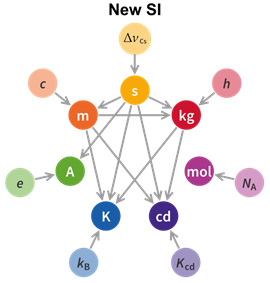Earlier this month, we spoke about the upcoming vote to redefine the kilogram not on a physical prototype, but mathematical constant. This vote has come and gone.
The revision was unanimously favoured by the General Conference on Weights and Measures (CGPM). Some small outside criticism exists, but the new SI will nonetheless be freed from its final reliance on a single, physical object.

© Emilio Pisanty, 2016-2018. Made available under the CC BY-SA 4.0 licence.
The key to the revision is in Planck’s constant(h): the relationship between the energy of a photon and its frequency. It’s such a fundamental part of our understanding of the universe that it plays a part in almost every physical model. No matter where in the universe you are, under any conditions, at any time, Planck’s constant remains constant. This is what makes it such a strong dependency for measurement; it’s not going anywhere.
Due to quantum mechanical weirdness and the precision of testing equipment, this constant is hard to nail down: readings fluctuate slightly between measurements. This fluctuation has always made it an unreliable point of reference for measurement, but even back in 1899, Max Planck himself proposed ‘Planck units’ as a basis for a huge variety of measurements, from spatial dimensions, electrical measurements, and even time itself.
However, in 2017, we had managed to measure Planck’s constant to such a fine accuracy that even with these mild fluctuations, it could reliably be used to determine SI base units (like our friend the kg). So accurate in fact, that the precision surpasses the IPK (International Prototype Kilogram aka ‘Le Grand K’).
So herein lies the 2019 redefinition of SI units. The idea is to ‘set’ Planck’s constant for the purposes of measurement (along with elementary electric charge, Boltzmann constant, and the Avogadro constant). This is similar in principle to taking pi as 3.14, even though pi itself has potentially infinite digits after that. With Planck’s constant set to an agreed value, the kg can be calculated mathematically with 100% certainty, instead of being reliant on a physical artefact that – try as we might – will always change in mass throughout its lifetime.
This won’t directly impact our lives, but has a significant affect on specialised fields, making a variety of measurements (including the kg) easily accessible to anyone, with reliable, fast, and certain compatibility.
Aside from quantum mechanical and electrical engineering fields, this has lasting beneficial implications for pharmaceuticals where even the tiniest deviations can make a big difference.
The new definitions will be in affect on 20th May 2019.
And it bears linking to again – this is largely thanks to the brilliant work that began with the late Dr Bryan Kibble, which you can explore in more detail here: http://www.npl.co.uk/educate-explore/kibble-balance/

 (5 votes, average: 4.60 out of 5)
(5 votes, average: 4.60 out of 5)